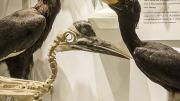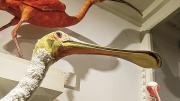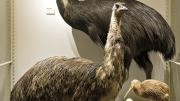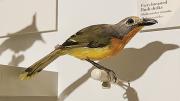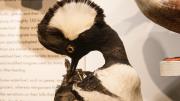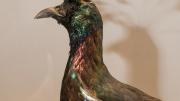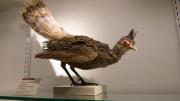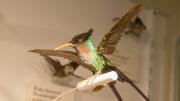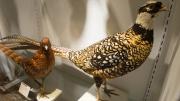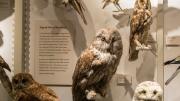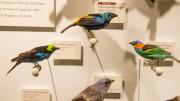The great mammal hall has been emblematic of the Harvard Museum of Natural History for decades. Traditionalists will be glad to know that the gorilla tirelessly pounding on his chest, the placid okapi, and the room-long whale skeleton are still in place, and birds still fill cases on the balconies that run all around the hall. But the birds are no longer solely the “Birds of North America,” as has been the case for ages. Like the University that houses them, they have become more cosmopolitan and are now “Birds of the World.”
“I’m staggered by their diversity,” said Maude Baldwin, a doctoral student and teaching fellow in organismic and evolutionary biology, whose particular interest is hummingbirds. She and Jennifer Berglund, an exhibit developer and writer, spent many months preparing this permanent exhibition, which opened last fall. First, they refurbished the elderly display cabinets themselves. To populate the cases, they drew on the vast collection of the Museum of Comparative Zoology—350,000 bird specimens—vacuuming the dust of years from feathers, brightening eyes to restore their shine, and revealing the color and iridescence of plumage through proper lighting. Then they made everything fit—and make sense.
Shown first are hornbills, mostly tropical birds who bear a large bill topped by a unique hollow structure, called a casque. The hornbill at right in the group is Buceros rhinoceros, the Malaysian state bird; the others are from Africa.
Next are a roseate spoonbill and two ibises. One might encounter the spatula-equipped wader in the southeastern United States or South America east of the Andes. The scarlet ibis is from northern South America. A white ibis is in the corner. A copper ibis, of course, may ordinarily be found on the dome of the Harvard Lampoon building.
The solitary bird is a fiery-breasted bush-shrike, from equatorial Africa. It is colorful even in its present circumstances.
The flightless southern cassowary can grow 75 inches tall. In front are another Australian resident, an emu, and a brown kiwi, a New Zealander. (The birds that follow are identified in captions.)
Baldwin and Berglund arranged their avian citizens to reflect not just biogeography but also current scientific understanding of the relationships among birds—their phylogeny. The result, Baldwin believes, is “both beautiful and correct.”
